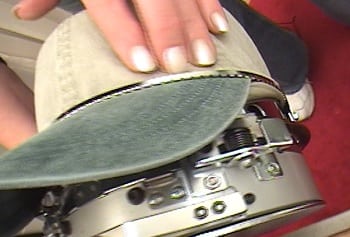
by The Embroidery Coach | | Embroidery Business Marketing
 I wanted to end this year of 2015 with a story about Howard & Amanda Potter, one of my most accomplished students! They own A & P Master Images of Utica, NY and built their business in 12 years from zero to $1,500,000 in sales in their decorating apparel business. I am so very proud of how they have worked so hard to build up a great business and of what they have accomplished in a few short years! Part of this story was written by me and part was written by Howard! I wanted to share this with you because many of you struggle so hard to even pay your bills or get to the point where you are making enough money to pay yourself a salary. I wanted you to see what is possible for each and every one of you!
I wanted to end this year of 2015 with a story about Howard & Amanda Potter, one of my most accomplished students! They own A & P Master Images of Utica, NY and built their business in 12 years from zero to $1,500,000 in sales in their decorating apparel business. I am so very proud of how they have worked so hard to build up a great business and of what they have accomplished in a few short years! Part of this story was written by me and part was written by Howard! I wanted to share this with you because many of you struggle so hard to even pay your bills or get to the point where you are making enough money to pay yourself a salary. I wanted you to see what is possible for each and every one of you!
Howard and I started working together almost 10 years ago and he has been a huge inspiration to a lot of people. He is kindly sharing his story with us.
“Some of you may know of me and some may not. I am a young man that had it rough growing up in life. So rough that at certain points I was at food pantries, and going to lawn sales for school clothes with my mother. From the age of eleven until I was eighteen, I grew up in the “House of the Good Shepherd” in Utica, NY.
After the group home I went to college for graphic design and during that time I met my future wife Amanda Potter. Shortly after two years of dating, we bought a house and got married in the back yard on August 31st, 2002, at the ages of 21 & 18. Within the year of being married, we had our first child Angelena.
wife Amanda Potter. Shortly after two years of dating, we bought a house and got married in the back yard on August 31st, 2002, at the ages of 21 & 18. Within the year of being married, we had our first child Angelena.
At that time I had an idea to start a graphics based business. I was working 60 plus hours a week pouring metal and started the business from a 15‚’x15‚’ room in our house as just a graphic design business at first. I quickly found out that just doing design could not be supported well in my area, so I started researching customizing apparel. When I was in college I learned the basics of screen printing. After some research, I came across selling promotional items, sublimation, and embroidery. I decided to still offer my graphics, and bring sublimation in house first since it was one of the cheapest options and no one really knew what it was.
I built my business up by farming out screen printing and embroidery while I was offering the promotional items. This was a good way for me to get going. I was putting in 15 to 20 hours a week with the business as a hobby since I had a great paying job.
After my second year in business we did about $30,000 in sales. Which really is not a ton, but I was having fun with the business. From there I started researching embroidery heavily and stumbled across “Tajima” embroidery machines which Joyce was a sales rep for Hirsch at the time. They got me in contact with her.
My wife and I went to her house and she showed us the basics of the equipment and took the fear from running a piece of equipment away in a matter of minutes.
From there, I had my goals set on bringing embroidery in house for several reasons.
- One I could run things and still design at the same time.
- Two it was clean.
- Three it did not take up a lot of space.
- Fourth and the most important reason. I knew Joyce could teach me how to run the equipment. After the single head embroidery machine was delivered, we set up a couple days of training with Joyce for my wife and I.
Within two days we started running orders and making money right away. My very first order on my own was for the group home I use to live in. It was a pretty cool feeling to be doing work for them. Within a year of owning our first machine. We purchased a second one right away.
When my daughter was 3 and a half, our family hit a road block. Our little girl was diagnosed with a very rare disease. She is only 1 of 3 kids in New York State that has what she has. While I was by her bedside, my employer was calling day after day to see when I was coming back to work. Which they had every right to, but I did not want to be held back by my job to be by my daughter‚’s side. I made her a promise that time in the hospital that I will always be there for her and took matters into my own hands. While I was with her, I had my computer and was working on designs for customers. That‚’s when it struck me that I could make money sitting from anywhere with my business and decided to focus on taking it full time.
 I worked over the next couple of years 80 plus hours a week to build the business up the right way. By the time I quit my job to work the business full time, I had closed out all of my retirement and paid off much of my personal debt to lower my monthly bills, and created a base of customers that could support my bills. That following year we did around $120,000 in sales from our home.”
I worked over the next couple of years 80 plus hours a week to build the business up the right way. By the time I quit my job to work the business full time, I had closed out all of my retirement and paid off much of my personal debt to lower my monthly bills, and created a base of customers that could support my bills. That following year we did around $120,000 in sales from our home.”
———-
I wanted to cut in here and give you a little history about how they worked together from the beginning. Amanda worked at the bank during the day and Howard took care of both the toddler and the baby while she worked. He also ran his business during the day and catnapped when he had a chance. Amanda took over running the machine during the evening and of course taking care of the babies while Howard took a nap before leaving for his job. He worked his regular job at night during this start up time. They have been an amazing team from the very start!
Now back to Howard!
“I am not telling you all of this to get you excited to think you can make quick easy money. My wife and I made many mistakes during these trying times, but Joyce was always there to give us guidance or teach new things that we did not know about the business. Because of Joyce we made less mistakes and were able to make more money faster on the embroidery side.
Everything she teaches you can make you money or save you money. I say can, because you have to be the one making it work. She can only teach it to you. You have to apply it. Really look at how much time and money is spent going to college. The average college degree is roughly $25,000 to $50,000 roughly, right? This is with no guarantee of making any money. Let‚’s do some basic math and see if you think this is worth it. Again, she can teach you anything about the business, but you have to work it.
I have probably spent at least $15,000 or more on teaching my staff and I over the past 10 years. Our company has produced $6,675,000.00 in sales over the past 12 years in business.”
 All of the sales may not be embroidery, but embroidery helped fund buying the equipment to help grow the business. This process allows you to do more work with less people. I have two full time staff in the embroidery department and this year we have done at least $375,000 in embroidery in a 20‚’x15‚’ room, two single heads, and a two head embroidery machine. Once in a while we will send an extra staff member in to steam, fold, and box. Really think about how tiny that space is. It does not matter how much you have, but what you do with it. Always remember that.
All of the sales may not be embroidery, but embroidery helped fund buying the equipment to help grow the business. This process allows you to do more work with less people. I have two full time staff in the embroidery department and this year we have done at least $375,000 in embroidery in a 20‚’x15‚’ room, two single heads, and a two head embroidery machine. Once in a while we will send an extra staff member in to steam, fold, and box. Really think about how tiny that space is. It does not matter how much you have, but what you do with it. Always remember that.
I am now 34 years old with a 5500 square foot building and adding a 3200 square foot addition to expand next year. Our company employs 15 full time staff, covers 50% of the health insurance if they want it, and now started retirement plans for them. Our company has won over 6 national awards, done work on four covers of national magazines for our industry, and has been published over 50 times in articles for these magazines.
expand next year. Our company employs 15 full time staff, covers 50% of the health insurance if they want it, and now started retirement plans for them. Our company has won over 6 national awards, done work on four covers of national magazines for our industry, and has been published over 50 times in articles for these magazines.
Your company is only going to be as good as the people you keep around you. I know professionals from every process we offer. I know all of my suppliers/ vendors.
Investing in having Joyce train you, is no different than investing into a college degree. Except you control how much you can earn, Not your employer! So, figure out what you want out of life with this line of work and go after it! Only you can stop you with the right training.”
———-
Howard has been able to do this because he has his processes in place, thoroughly trained his staff, he plans each and every step of his progress and he knows his numbers! Howard has always known his numbers! At the end of 2015, he will be at the $1,500,000 mark! That is incredible for the amount of employees that he has. This type of growth does not happen overnight and it does not happen by accident! You must have a plan and work your plan diligently!
Amanda is in charge of accounting and is very involved with inside sales. Together they work very closely running their business and they are a true highly productive team and partnership!
Howard has stuck to retail sales, not contract work! I told Howard from day one that he would not be able to make it in this industry doing contract work for other companies and that he needed to stick to retail sales only. You need to be able to provide the product as well as the embroidery to build up a great business, especially when you are building up your business the way that he has. Contract work is done for pennies on the dollar compared to retail and unless you have a huge shop with many embroidery heads, you have to work too hard to make it happen!
 Howard‚’s business is a full in house source for anyone needing any type of graphic design work and promotional products. He offers everything from pens and cups with your logo on it to car wrapping! He offers it all!
Howard‚’s business is a full in house source for anyone needing any type of graphic design work and promotional products. He offers everything from pens and cups with your logo on it to car wrapping! He offers it all!
He has perfected each decorating process and each department including the right person to carry out that decorating process before going on to the next type of process. You cannot start them all at one time and expect to make a go of it, it does not happen.
You also cannot expect to be a one man shop and offer all of the different types of decorating processes. Many people make the mistake of trying to offer all types of services to their customers and they are not capable of doing any one to perfection! DO NOT MAKE THIS MISTAKE!
I am proud of what Howard has become as a man, a business owner, a husband and a father. He has 2 children now and both of them have some duties inside of the business. Howard is a very devoted father and he and Amanda are raising their children right with a great work ethic and wonderful life values. He provides family vacations, and spends a balanced life between his decorating apparel business and his family!
has 2 children now and both of them have some duties inside of the business. Howard is a very devoted father and he and Amanda are raising their children right with a great work ethic and wonderful life values. He provides family vacations, and spends a balanced life between his decorating apparel business and his family!
This is possible for anyone, but it takes planning, perseverance, the willingness to implement what you have been taught and the right attitude!
Thank you Howard for sharing your story with us and I look forward to another great year of working with you!

by The Embroidery Coach | | Embroidery Business Marketing
0I have had questions about cap embroidery lately and I want to give you some 9 basic rules for easy cap embroidery that are going to help you as you are struggling with those caps! Caps are not very difficult once you get the feel of hooping them properly and following the rules that are no important when you are working with caps.
- Make sure your design is the right size for the cap! Your embroidery design for a standard cap should not be more
 than 2.10 inches high and if you are working on a low profile cap, make sure you stay within a 2 inch limit. You will have much less issues and a better result if you follow that rule!
than 2.10 inches high and if you are working on a low profile cap, make sure you stay within a 2 inch limit. You will have much less issues and a better result if you follow that rule!
- If your design as a long line of text at the bottom, keep your design within 2 inches even if it is NOT a low profile cap. The bottom line of lettering will pull up and be distorted if it is too low on the cap.
- When you are hooping your cap, make sure that the cap facing is
 really tightly tucked under the lip of the cap framing device and that the metal strap is tight and stays in place across the front where the brim and cap are sewn together.
really tightly tucked under the lip of the cap framing device and that the metal strap is tight and stays in place across the front where the brim and cap are sewn together.
- Use clips on the side of the cap. Many embroiderers do not use the clips and wonder why the embroidery does not stay in registration or why the cap moves! This is extremely important is you want a high quality finished design.
- Make sure the bottom of the design is at least one-half inch up from the metal strap on the cap hooping frame where the cap front and brim are sewn together. Some caps are very stiff at the bottom and there are several layers of fabric and facing sewing together. If you are too close, it will be distorted.
- For best results, always start your design from the bottom up and from the center out. For better registration always
 finish one section on the design before going to the next if at all possible.
finish one section on the design before going to the next if at all possible.
- Always use cap backing when you are hooping your caps, regardless of how heavy or stiff your cap is. This also will help to produce a higher quality embroidery design on your cap. I have found that a 3 oz. tearaway cap backing is the best choice.
- When you first start to sew out your design, walk the machine, until it gets past the center seam. This will help to keep the needle from deflecting and breaking or getting caught in the center where all of the layers of fabric and buckram are sewn together. What is meant by walking? Hold your finger on the Start button so that it just creeps until it is past that center point.
- I use a 70/10 Sharp needle for all of my caps, but sometimes on the very stiff caps, a heavier needle such as a 75/100 sharp will work better, depending on the machine and cap frames.
If you are struggling with caps, follow these 9 basic rules for easy cap embroidery and keep practicing until you get it right! Caps can be your biggest money maker! If you still continue to have issues, you can learn how to embroider caps very easily through videos on my website. https://EmbroideryBusinessAcademy.com

by The Embroidery Coach | | Embroidery Business Marketing
I have worked with clients that have been looking at the possibility of merging with another business to increase their business, to add on to what they have to offer and even to increase the workforce, but you need to take a long hard look at make sure that you are solid in what you really want and are looking for. Many times we get into situations on a hand shake and believe me a hand shake is not enough. We soon find ourselves disappointed in the end result.
I was working with a client this past week that was in the process of buying into a business and after taking a real hard look at the inside of it, he decided that it was not a good investment and reading this article really made him realize that it may not be a good investment of his money or time!
I also want to say a little bit about you as being on the inside or the person that is looking to find an investor, make sure that EVERYTHING is in writing including all of the promises made by the investor! I was in a position at one time where the buyer of my business made me a lot of promises, but after the sale had taken place, I found out it was all just a lot of talk to make sure I was on his side! He did not make good on any of his promises and I DID NOT have those promises in writing! A hand shake is not enough, it does not work!
I learned much of what I teach today and the bad experiences that I have gone through by experience and it was not all good experiences! PLEASE learn from my mistakes and do not make your own! I definitely learned that a hand shake is not enough!
I want to share an article that I found that I want you to read over and over! This article is extremely important and how you should be structuring your business as it grows. When it comes time to sell your business or look for an investor to help you grow your business, these are the items that are vital to a buyer or an investor! I am including it word for word from the author, Mark Morgan Ford!
4 Rules About Business
If you read financial writing for any length of time, the jargon and acronyms will overwhelm you. Consider the many tools used to value a business: P/E ratios, enterprise value (EV), free cash flow (FCF)… The list is endless and confusing.
Fortunately, there is a real-world, common-sense method for evaluating businesses. Use it the next time you consider an investment.
These are the only four rules I follow when evaluating a business.
Rule No. 1: I must understand and be comfortable with the way the business works.
First and foremost, I have to understand and be comfortable with how the business acquires (or, in the case of startups, intends to acquire) new customers. I need to know what media it will be using, what kind of advertising campaign, what sorts of offers and copy approaches it will be using, and what all this will cost on a per-customer basis.
And all of that needs to make sense.
Next, I need to know and be comfortable with how it plans to optimize those customers, what sort of additional products and services it will offer them (at what price points), and the timing.
I’m looking for an estimated value of each customer, depending on media and advertising strategies, in the first and subsequent years. I also have to understand the product, why there is a demand for it, and how the company can sell that product better than its competition.
Rule No. 2: I have to understand the industry and believe it is trending up.
This is as important as the first rule maybe more.
Understanding an industry is a challenge. Every industry has its own dynamics.Retail, manufacturing, and wholesale businesses all operate differently from one another. And within each industry, each sector has its own rules.
Clothing stores and bars, for example, are both retail businesses, but they require very different approaches. Inventory (what you have in stock) is a complex and critically important decision for clothing stores. But, it’s a rather minor and obvious factor in running a successful bar.
Here‚’s the thing about industry knowledge: You can‚’t find the most important factors in spreadsheets or in books on business. (Not even in For Dummies guides.) You have to have experience actual experience in the industry.
That’s why I very seldom invest outside the half-dozen industries I know. And when I do break this rule, I almost always lose money.
If I understand the industry, it’s relatively easy for me to know which way it’s trending. I will already know the major players and be aware of how they are doing. I will have an idea about what new products and companies are coming into the market and what older products and companies are moribund.
What I want is an upwardly trending industry or sector within an industry.That‚’s important because, as the saying goes, a rising tide lifts all boats.
I don’t rely on data compiled by analysts for this. It‚’s often created and paid for by companies with a vested interest in the results.
Rule No. 3: I have to understand the financials, and they have to be solid.
If I’m comfortable with the business plan and the industry trend, I look at the profit and loss (P&L) statement, the balance sheet, and the marketing data/projections.
Since I have no formal education in finance, I’m not particularly adept at analyzing numbers. But, if they are related to businesses I know, I feel comfortable looking at them because I know what to look for.
If, for example, I‚’m looking at an Internet marketing or publishing business, I have a very good idea about what the revenues, expenses, and profit margins should be. I will also have a good idea of what normal growth looks like… and where the dangers may be lurking.
For example, with a subscription-based publishing business, something called deferred subscription liability will show up in the balance sheet. This is a very important number. An accountant may have no idea whether it is an actual liability or a hidden asset unless he or she knows the business and industry.
If I’m looking at a company from another industry, I won’t understand. And if I don’t understand, I’m likely to overlook something.
Another thing I look for is cash and cash-flow. I want to feel sure the business has sufficient cash to sustain itself while growing. The first few years of any startup are always a challenge in terms of cash flow. And what is needed often exceeds what you believe you will need when you begin.
I don‚’t believe in over funding startup businesses. I like when the leadership team is very careful about its spending. But I don’t want the business to fail simply because it runs out of cash too soon.
Rule No. 4: I have to believe in the people running the business and believe they will allow me to have some input into their key decisions.
The business plan can be strong. The industry can be trending up. And the numbers can be solid. But, if I feel even the slightest bit unsure about the principal players, I will pass.
This is a very important rule. It’s also a rule I have broken in the past. Every time I’ve broken it, I’ve come to regret it.
I‚’m looking for proven experience, emotional intelligence, healthy ambition, and, most of all, good character. For me, character counts most because, as an investor (rather than a controlling partner), I need to trust these key people to develop the kind of business I can be proud of.
Also, I want a say in how they are going to build the business. I don‚’t want to be the boss,but I want to know they would at least listen if I felt they needed my advice about product development and marketing. In the early stages, especially.
These rules have worked for me as an investor on the private side. And so, I was happy to learn from my reading that they were similar to the rules Warren Buffett used in making decisions about investing in public companies.
About the Author: Mark Morgan Ford was the creator of Early To Rise. In 2011, Mark retired from ETR and now writes the Palm Beach Letter.

by The Embroidery Coach | | Embroidery Business Marketing
I hear over and over from people that have purchased their embroidery machines with all good intentions to start building their own home-based embroidery business but they just get stuck. They soon discover that there is so much to do but they really do not know how to get started. They have no plan and all of a sudden, the feel like they do not have the time to get their business started.
Are you one of those people that believe that you just don’t have the time to get your home-based embroidery business up and running? You‚’re not alone. Many people I talk to claim they have too much to do and not enough time to do it. They wind up defeating themselves and their business loses momentum and suffers.
A job outside the home, running with the kids or taking care of other family members, maintaining your health and too many other distractions are the main reasons for not building momentum in your business. You end up feeling that your entire life is spent catering to everyone else‚’s needs. However, I have some good news for you! You can find and maximize time to start building momentum in your home-based embroidery business right away. All you need is to find time and commit to use that time wisely for your embroidery business only. Try the following strategies to make your home-based embroidery business flourish.
Document Your Daily Routine
The first thing you will need to do is find a quiet place and write down your daily schedule. Document the start and end time on events like getting ready for work, driving your kids to school, your commute to your day job, gym time and any other weekly commitments you presently have. Don’t forget to include weekends and family time (this is very important).
After completing this exercise you should have a good visual of what your work week really looks like. You may see openings in your week that you can use to start building your embroidery business. Make your goal easy to reach: try to find two hours you can commit to spending on your business. You may be able to find some chores or events that you can delegate to someone else. Do not hesitate to ask a family member for help! It may also be a matter of re-prioritizing some activities in order to create a new schedule.
Stick With The Schedule You Created and Re-Evaluate It
The next thing you need to do is stick to your new schedule. This can be tough because you are creating a new habit. Once you and your family get the hang of your new routine, you can re-evaluate your schedule. You may be able to find more time to spend on your home-based embroidery business.
Sticking with your new schedule means you need to discipline yourself to work on your business and only on your business during that scheduled time. This means that you may need to find this time after work, after little league games, after dinner or after putting the kids to bed. I know that this is a hard time of the day to start something new, but it is going to be a big benefit to you if you will discipline yourself to stick to it!
Don’t Forget To Spend Time With Your Family.
Spending time with my family has always been a top priority for me. When I had young children I tried to focus on my business when my kids were in bed. I found that using the evening hours was best for me to spend on my home-based embroidery business. It seemed to be the most quite part of the day and I could accomplish a lot in 2 hours.
If you have to use your family time to spend on your business, make sure your family knows what to expect along with what you are doing and why you are doing it. However, I would recommend that you set a time limit so you can spend as much time as possible with your family. This will help to provide balance for you.
Embrace Your Many Distractions
As we all know life happens and can throw off our whole schedule. Try your best to embrace that fact instead of fighting it. If your child stays up late, focus on helping your child quiet down and go to sleep. Try not to focus on what you could be doing. The work will still be there when you are ready and you will feel much better knowing that you could be there for your child!
If you have to stay late at your day job, then choose to work late. It is better just to focus on one thing at a time. You‚’ll be more efficient and effective on your job, with your family and in your business. Having a clear and guilt free mind while working on your home-based embroidery business is very productive.
If you get a new idea that can distract you while you are working, keep an MP3 Recorder or your IPad handy so that you can record it immediately or write down the idea in a notebook. You can always prioritize those thoughts at a later time. You will also find that you are using less energy dealing with distractions instead of fighting them.
Finding time to work on your own business is very doable! Don‚’t despair and don‚’t get frustrated. Just remember that you have total control of your time and you alone can change your habits to start building momentum in your home-based embroidery business! I have created a program to help you get started the easy way and be able to plan out your home-based embroidery business before you actually get started. Go to HowToStartAnEmbroideryBusiness.com It will help you organize your thoughts and keep you out of overwhelm while you are building your embroidery business!

by The Embroidery Coach | | Embroidery Business Marketing
Do you feel like a raise in pay for embroidery employees is the answer to keeping them happy and productive? Maintaining a loyal and satisfied workforce by being creative with your benefits can be an affordable option to increasing wages. You need total team work and co-operation from all of your employees at all times whether they are full-time or part-time employees. There are several ways to gain loyalty and get their best possible effort and co-operation without a raise in pay for embroidery employees.

- Creating flexible working hours for employees that cannot always conform to a strict work schedule of the 7 to 3:30 or 9 to 5 workplace can give you employees that are excellent. For example, moms that have school age children, that need to care for their children around the school schedule. Or a person of retirement age unable to work a full-time schedule or perhaps one that needs time off to care for a loved one. In these cases, the flexibility is very important to the employee and they will typically give their utmost efforts and make good loyal employees.
- Have a group meeting once a week or twice a month and let everyone know how the company is doing. Employees like to feel that they are truly a part of the team and this is one way to gain their trust. When meetings are continuously private, employees become very suspicious and untrusting.
- Treat each employee as if they are the most important person in the workplace. By recognizing the importance of the individual and every job position, you create a friendly, family atmosphere. Each and every job position in the business is dependent on the job previous to and after it. Maintaining this atmosphere in a small workplace is very important. One of the ways to accomplish this is by being present on the floor and periodically checking the work throughout the day yourself. You will gain more respect and employees will try harder to please you. It is very important to convey that you are happy with their performance.
- Express the importance of each and every job position as part of the entire manufacturing process. They all need to be done correctly for the next person to do their part correctly. This is true all the way thru from the Order Taker to the Shipper.
- Wear a smile at all times showing your positive attitude, even when there is a problem present. This is a huge reflection on the entire business. You need to have the position that you are not attacking them for a problem, but trying to solve the problem.
- Include them in proposed changes in the organization, systems or processes of production. By having a meeting to inform them of your plans and asking for their input helps to conquer their fear of change. Production workers can be very insecure and will fight every change that is made whether it is a good or bad, unless they know how it is going to affect them. Feeling that they are part of the change will be much easier to get their co-operation.
A raise in pay should be given on merit and job performance alone and not on longevity. Using this method of increasing salaries gives them the motivation to keep striving for better performance and learning new job skills. A raise in pay based on longevity alone does not motivate anyone to strive for higher performance. Yes, they do need cost of living increases but not an increase based on length of employment.
Surprise them with a treat every now and then. This is another huge way of gaining co-operation and showing appreciation. It does not have to be expensive. A few hours off with pay for when they have done something extraordinary, or even a hot fudge sundae from McDonald‚’s goes a long way in making them happy. Make sure that they are rewarded for their extra efforts. This is something that I did about once per month and no one knew when it was happening. When I would come into the shop with hot fudge sundae‚’s or a pizza, their eyes lit up and they were very happy! This has always been a hugely successful tactic for me to gain co-operation and loyalty!
By utilizing the above benefits, you can build a happy workforce and a more positive working atmosphere without always giving a raise in pay for your embroidery employees.

by The Embroidery Coach | | Embroidery Business Marketing
“9 Tips To Avoid A Financial Crisis In Your Embroidery Business” is an article that I wrote a few years ago and I thought that I would bring back the content of that article because it is so relevant in today’s world!
We have seen so many changes in how we have to do business and how we market our business but when it comes to the financial end of our business, it stays the same. The cost of doing business keeps soaring and we must pay close attention to the day to day operation and do everything that we can to avoid a financial crisis!
In today‚’s world of business, having a superb product, soaring sales and excellent customer service are some of the things that go into making a successful business, but if you do not keep your business financially healthy, all of that hard work will be in vain. Without a sound stable financial position the slightest shock can be enough to send your embroidery business crashing to the ground.
Here are 9 items that can cause your embroidery business to sink and you need to stay on top of each and every one of them in order to avoid a financial crisis and keep your business alive.
Poor Record Keeping
Embroidery Business owners are usually not good record keepers! People who start embroidery businesses are creative and love being in the creative space, bookkeeping is not something that makes them jump out of bed in the morning! They do not get up thinking! “Great, I get to do paperwork today!”
If you are to keep your business going and growing then you have to accept that there are going to be days that you can‚’t avoid it. You must keep records of your sales, your purchases, your production time, and your inventory.
Without these records you will very quickly lose track of where you are. You won‚’t know:
- What you have spent your money on
- You won‚’t know where your cash is going
- You won‚’t know how much you have in inventory
You are effectively working in the dark and this is not conducive to financial stability. So what sort of records are we talking about? Nothing sophisticated. It can be as simple as a book with one page for your income and another for your expenditure. At least once a month total it all up to see how money you have made (I hope!). There‚’s a saying. ‚ÄòThe people who keep records are the people who break records‚’ ‚Äì so true.
Not Keeping Track Of Your Bank Balance
Do you know exactly what your bank balance is today? Why is it important? If you are going to write a check you must know that you have the money on your account. If your check bounces it can damage your reputation and have a negative effect on your credit. This can cause a struggle when dealing with suppliers.
To avoid this make sure you keep a running total in a check book at all time and even get a line of credit so that you can draw on when the cash flow gets low. This can really help in those slow times, but you must repay the line of credit as soon as the cash starts coming in. There really is no excuse for losing track of where you stand.
Poor Cash Flow
When you are working with your customers and purchasing products for them you need to be asking for at least 50% down and then get the remainder of the payment when he or she picks up the order. If you deliver the order, you must collect the remainder before leaving the products.. You cannot afford to work with your money. You need to be working with your customer‚’s money. Carrying Accounts Receivables can kill your business very quickly.
No Cost Controls & Purchasing the Wrong Things
When you are going to make a new purchase, shop around to make sure you are making the right decision. Compare prices and specifications especially on larger purchases. Have your budget set before you start shopping for that new purchase.
Make sure you spend your hard earned cash on the right things. Your business, in order for it to grow, needs cash. Remove the cash and you remove the life blood which keeps your business alive.
You have to be disciplined when planning a new purchase. Always ask yourself the question, ‚ÄúWill this cost add anything to my business? Is it going to help me increase sales?‚Äù Don‚’t act on impulse; go away and think about every large purchase. If it is not going to help increase your sales, then the decision to purchase a new item is not the right one.
Failing To Make Necessary Cuts
Failing to make the necessary cuts to ensure the survival of your business is something you cannot afford to do. If you have an employee that is doing your purchasing for you, keep a check on him or her to make sure that they are not purchasing more than necessary. If your work load decreases, cut some of your labor costs. Do not try to keep them hoping it will pick up, this will be a huge drain on your cash flow. If you notice you have any type of problem do something about it immediately! Don‚’t sit back and hope things will get better; as a general rule, they do not!
If you have product or service that is costing you money, get rid of it. Not acting quickly will only compound the problem.
Depending On a Small Number of Customers
Having a small number of customers is not a problem when everything is going well, but if one or two leave you or fail to pay up on time, then this can cause problems.
If you depend on 3 customers and one of them leaves, you are faced with a 33% reduction in sales. Unless you can replace him immediately you may not be able to cut your overhead costs quick enough to avoid any crisis.
You cannot afford for your business to be held to ransom. Get out as quickly as you can and get new customers.
The same situation can apply to a business that only offers one type of decoration, such as embroidery. A shift in the economy can cause your customers to decide on a more cost effective alternative and all of a sudden, you have no embroidery. You must diversify and offer more cost effective alternatives to your customer when times get tough to keep your customers coming back for more of what you have to offer!
Not Having a Budget
At the beginning of each year sit down and go over your financial reports with a fine tooth comb, Based on your previous year‚’s income and expenditure, create a new budget. Look to see where you can cut back on or even what to cut out altogether if that is necessary to keep costs in line.
Having a good sound budget will help you make the right decision before making any large unnecessary purchases.
Having a good budget will provide you with the discipline to keep track of your expenses. At the end of every month update it by comparing your budget with your actual expenses. Going through this exercise will help you focus on what your business is actually doing.
No Contingency Plan In Place
All business, large or small need to have a contingency plan for all area of the business. A contingency plan is basically a plan which answers the question, “What would we do if this happened …?”
If you are a small embroidery business and basically a one person business you are at even a bigger risk than a larger business that has several employees. If you are ill for a month or two and could not work, who will help you get through that bad time. Do you have any type of insurance that is going to help pay the expenses and give you a salary in order to help you though this time?
Do you have procedure manuals written for all parts of your business so that someone else can step in and take over that part? You need to have a manual for each area of your business that shows how that part of the business works, how each process is done. This includes your office. If something does happen then someone else can follow your instructions and at least keep it going for you. You need to have instructions written down for the entire business flow. Do not depend on your memory to be able to tell someone else what to do. In a time of crises, your brain does not function as normal and this is impossible.
You must do everything that you can to avoid such a crisis! Having good procedural manuals in place is a huge part of that contingency plan.
Not Talking To Your Bank Manager or Loan Officer
As soon as most people see a financial crisis on the horizon, they try and avoid their Bank Manager or their loan office! This is the first person you should speak to. Bank Managers like to be kept up to date with what is happening in your business. They don‚’t like surprises. When they are kept in the dark they can make decisions that can have a major impact on your business. You must go to your bank the moment you suspect there is a problem. Who knows, he may surprise you by offering to do something to help!
Financial problems can usually be avoided by taking a step back from the business and thinking about what can go wrong. Act as an accountant or a trusted adviser and look at your business in that manner. Once you do that, then you can take actions to put preventative measures in place to avoid a financial crisis before it‚’s too late.
I work very closely with many embroiderers and I find that the 9 tips in this article are extremely important to almost all of them. As embroiderers we were not trained to be financial geniuses or business people at all! We are embroiderers that totally enjoy the hands on of performing our day to day operations and creating our designs! The financial end of the business is hard for most of us! Thoroughly read this article, think about your business and what you can do to make the necessary changes in it to avoid any of these financial crisis!










 than 2.10 inches high and if you are working on a low profile cap, make sure you stay within a 2 inch limit. You will have much less issues and a better result if you follow that rule!
than 2.10 inches high and if you are working on a low profile cap, make sure you stay within a 2 inch limit. You will have much less issues and a better result if you follow that rule! really tightly tucked under the lip of the cap framing device and that the metal strap is tight and stays in place across the front where the brim and cap are sewn together.
really tightly tucked under the lip of the cap framing device and that the metal strap is tight and stays in place across the front where the brim and cap are sewn together.



